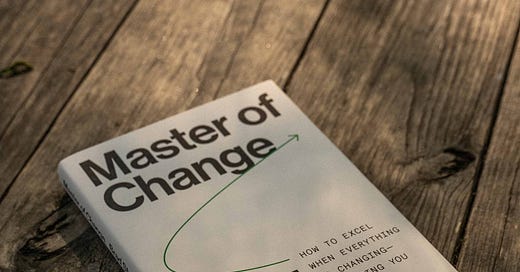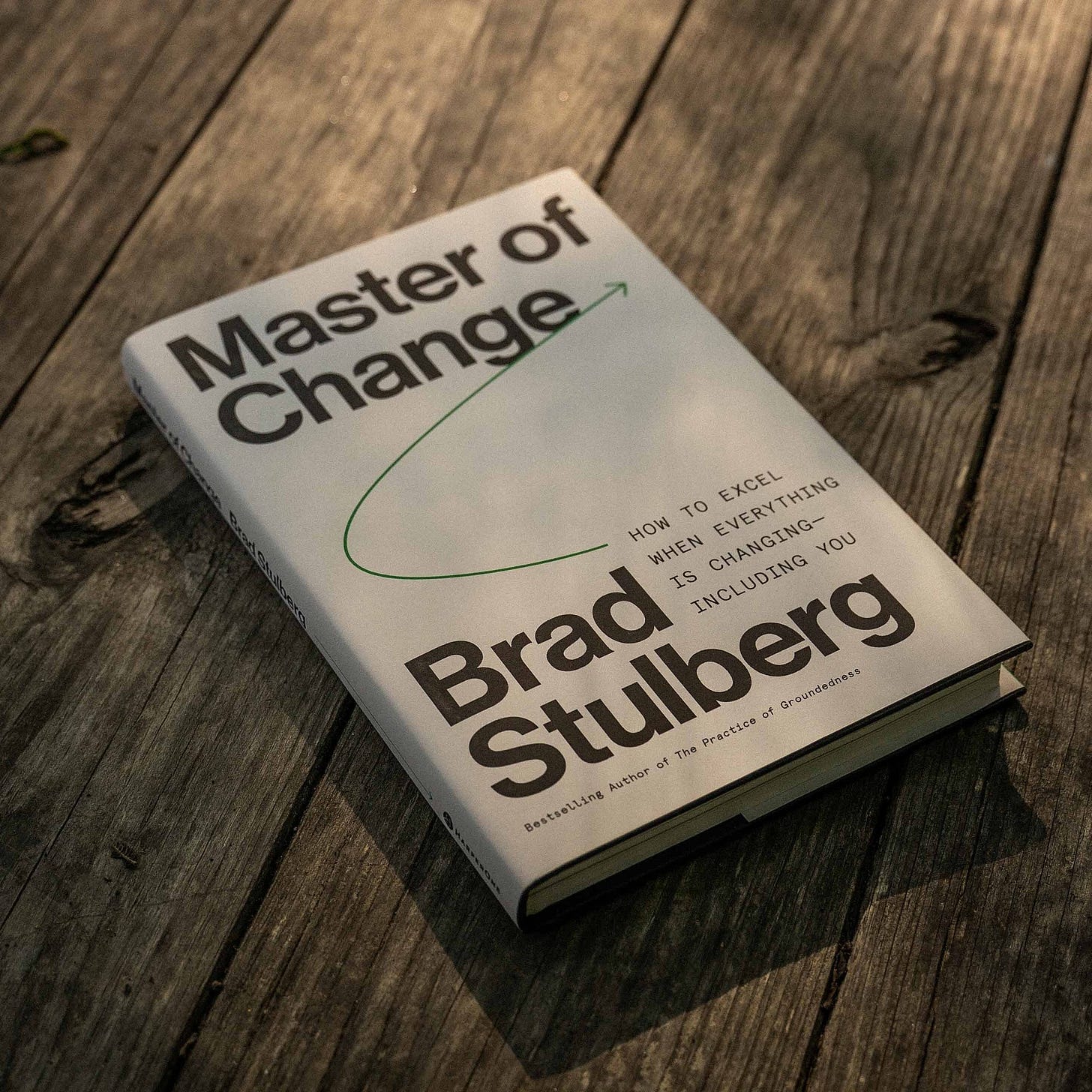You’ll learn: Four ways to adapt to change (the only guarantee in life!)
Quick Housekeeping:
All Monday posts and their audio versions are always free.
Coming up this week on 2%:
Wednesday, we’re covering the science of outliers and what it can tell us about how to find a diet, exercise routine, and more.
Friday is November’s Burn The Ships. Get excited. Get nervous. Get excitedly nervous.
If you want full access to Wednesday and Friday posts, become a Member below.
We’re selling my favorite rucking pack—the GORUCK Rucker 4.0 in Black with the Don’t Die Orange interior—on the 2% shop. Check it out.

During the pandemic, it was common to hear people talk about wanting to “get back to normal.”
That didn’t happen. Because here’s the thing: Once you go through a change, you’re never the same. This is the rule for both big and small changes.
But here’s the good news: If you play your cards right, you can come out the other side of change a better, higher-performing person.
That, to me, is a tenet of mental toughness and self-reliance. Can you not only roll with change, but use its kinetic energy to your advantage?
Which leads me to today’s guest post. Brad Stulberg is like a master poker player who teaches people to play the right cards.
Brad writes and coaches on health, well-being, and sustainable excellence. He’s the author of the new book Master of Change. It’s both a timeless and timely read.
We’re in a massive period of change. “There’re geopolitical changes, there are changes in work and technology, and we live in a world of distraction and non-stop candy from all the candy dispensers in all areas of our lives. It can feel like there’s more chaos and more frenetic, frantic energy in life than there really is,” Brad told me.
Brad was kind enough to share a few big ideas from Master of Change on 2%. In a world filled with people trying to sell you the next hack, you can trust Brad.
I highly recommend Master of Change to anyone who may encounter a change in the future. That is to say, you.
Here’s Brad.
1. Think: Order, Disorder, Reorder
In short
Change is neutral. It becomes negative or positive based on how you view it—and, more importantly, what you do with it.
The details
The average person undergoes more than 30 significant life changes.
Marriage. Divorce. Having kids. Starting school. Graduating. Moving towns. Becoming sick. Recovering from illness. Starting jobs. Leaving jobs. Promotions. The list goes on and on.
Our models for navigating change are old and outdated. Old models represent changes as a cycle of order, disorder, order—like we’ll eventually get everything back to “normal.”
But this is neither accurate nor how life actually works. Fighting to get things “back to normal” is a waste of energy. More importantly, it leaves progress on the table.
A better and more accurate way to view change is seeing it as a continuous cycle of order, disorder, reorder. It’s up to you to do the reordering.
The latest findings from psychology, biology, sociology, philosophy, and neuroscience all demonstrate that change itself is neutral. It becomes negative or positive based on how you view it—and more importantly, what you do with it.
Know that change may shape you—but you can also shape it.
2. Develop Rugged Flexibility
In short
Developing the quality of rugged flexibility will help you navigate change and thrive during it.
The details
Happy, healthy, and sustainably performing individuals maintain strong and enduring identities by repeatedly remaking themselves.
They enter into the river of change and arrive at an enhanced sense of self and stability somewhere new.
They’re not so rugged that they never change. They’re also not so flexible that they passively surrender to the whims of life.
They marry these two qualities and practice a mindset and a way of living called rugged flexibility.
To be rugged is to be tough, determined, and durable.
To be flexible is to consciously respond to altered circumstances and conditions, to adapt and bend easily without breaking.
Rugged flexibility is about maintaining a strong core identity—based on what you value most—but at the same time being able to adapt, evolve, and grow.
Define your sources of ruggedness—your core values—and then work on applying them flexibly in new ways as your life changes.
3. Diversify Your Sense of Identity
In short
Much like you want to diversify an investment portfolio to be more robust in the face of change and chaos in financial markets, you want to do the same with your identity.
The details
If you want to be really good at something, you have to be willing to fail. But the more you define yourself by any one activity—that one thing you want to be good at—the more fragile you become.
If that activity doesn't go well or changes, you lose a sense of who you are.
A better path is to develop "self-complexity," a term researchers use for having multiple components to your identity.
We all wear many hats. Examples include: employee, spouse, parent, athlete, artist, neighbor, entrepreneur, creative, baker, gardener, adventurer, and so on.
Take an inventory of your own identities. Are there any upon which you are over-reliant for meaning and self-worth?
It’s not that going “all in” on a certain endeavor is bad. It’s often necessary for big projects and life events. But you must ensure that you don’t leave the other parts of your identity completely behind.
Challenge yourself to integrate the various elements of your identity into a cohesive whole. This allows you to emphasize and deemphasize certain parts of your identity at different periods.
For example: there are times when I lean heavily into each of my main identities—father, husband, writer, coach, friend, athlete, and neighbor.
I’ve learned that keeping all of these identities strong ensures that when things don’t go well in one area of my life I can rely on other parts of my identity to pick me up, which helps me to stay grounded and navigate whatever challenge I am facing.
4. Respond, Don’t React
In Short
In the midst of distress or the unexpected, make decisions from a place of thoughtfulness and discernment, not rage (and eventual regret).
The details
Reactions tend to go like this: Something happens. You panic. Then you proceed.
Responses tend to go like this: Something happens. You pause. You process. You plan. Then you proceed.
Reacting is quick. Responding is slower.
Responding creates more space between an event and what you do (or don’t do) with it. In that space, you give immediate emotions some room to breathe. You take stock of what is happening, plan using the most evolved part of your brain, and then move forward accordingly.
Responding is harder than reacting. But, like most things that require effort, it also tends to be advantageous.
In a series of studies out of UCLA, researchers subjected participants to unplanned and distressing situations, such as giving impromptu speeches in front of strangers.
Half the participants were instructed to label their emotions. For instance, “I feel tightness in my chest,” “I feel angst in my throat,” or “I feel heat in my palms.” The other half were not instructed to do anything special.
The participants who felt and labeled their emotions, what researchers call affect labeling, had significantly less stress and felt more at ease during their speeches.
Next time something distressing comes up, pause, label it, then make a quick plan on how you’ll respond.
While it might seem that owning your insecurity would give it more power over you, it’s the opposite. When you identify your emotions—especially the negative ones—it lessens the likelihood that the emotion will control you. It switches you out of being fused with your emotion (reaction mode) and into a more thoughtful state (responsive mode).
//
Michael here again. Thanks to Brad for sharing just a few of the great ideas in his book Master of Change. Get Master of Change here.
Have fun, don’t die, be a master of change.
-Michael
Sponsored by Maui Nui Venison
Axis Deer provides the healthiest meat on the planet. That's according to researchers at Utah State, who compared axis deer meat to beef and found that it contains 1 to 64 times more antioxidants, vitamins, minerals, and healthy fats. It also contains 53% more protein per calorie than beef. Here's a fascinating brief on the research. Equally important is that Maui Nui solves ethical considerations around meat. Axis Deer are an invasive species ravaging the Hawaiian island of Maui, and Maui Nui harvests the deer at night in a stress-free way, improving the ecosystem.
My picks: I like it and eat everything from Maui Nui, but the 90/10 Organ Blend is particularly great for people looking to get more micronutrients in their diet, and the Jerky Sticks are my go-to travel snack.
**Use discount code EASTER for 15% off.**
Sponsored by Momentous
Momentous made me feel good about supplements again. Over 150 professional and collegiate sports teams and the US Military trust their products, thanks to the company’s rigorous science and testing. I don’t have the time or desire to cook perfectly balanced meals that give me all the necessary nutrients and protein I need (let’s face it, few of us do!). So I use their collagen in the morning; Recovery protein during hard workouts; essential multivitamin to cover my bases; creatine because it’s associated with all sorts of great things; and Fuel on my longest endurance workouts on 100+ degree days here in the desert (because Rule 2: Don’t die). And I also love (love!) that Momentous is researching and developing women-specific performance supplements.
**Use discount code EASTER for 15% off.**
Sponsored by GORUCK
When I decided to accept sponsorships for this newsletter, GORUCK was a natural fit. Not only is the company's story included in The Comfort Crisis, but I've been using GORUCK's gear since the brand was founded. Seriously. They've been around ~12 years and I still regularly use a pack of theirs that is 11 years old. Their gear is made in the USA by former Special Forces soldiers. They make my favorite rucking setup: A Rucker 4.0 and Ruck Plate.
**Use discount code 10EASTER for 10% off anything from GORUCK.**





Absolutely amazing book and lessons. I wish I had found Brad sooner. We moved to a new town, bought our first house then Covid hit all within a handful of months. We got through that and then our son got really sick. Then he got PTSD from having been sick and had to be home schooled for a bit. He got back to in person then my wife lost her job unexpectedly of 23 years. My wife just found something 7 months later at half her salary so she has something. Then I found out I have to go back to the office after being told I didn’t. What I’ve learned from Brad was how to be ruggedly flexible so I don’t curl up in a ball. Life just hammer so many of us and the lessons in this book are worth their weight in gold. I’ve told Brad how much he’s helped me. I’d hug him if I ever met him :)
Great book - well worth the read! Also really enjoyed Shane Parrish's Clear Thinking - similar but different.
Random off topic question - as we hit the winter months I am looking at adding a treadmill to my garage gym. What do folks recommend if the primary usage will be inclined rucking?